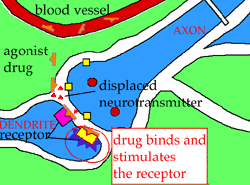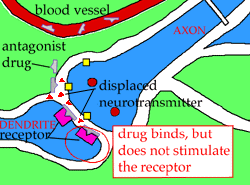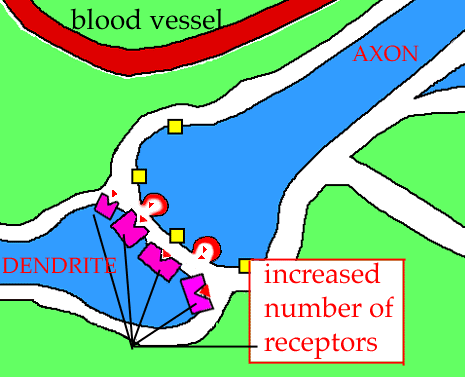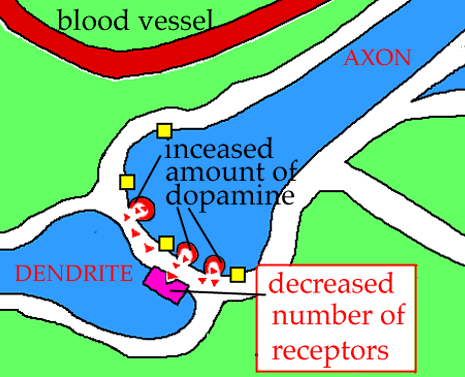Understanding addiction
One of the neurotransmitters playing a major role in addiction is dopamine. Many of the concepts that apply to dopamine apply to other neurotransmitters as well. One of the neurotransmitters playing a major role in addiction is dopamine. Many of the concepts that apply to dopamine apply to other neurotransmitters as well.

Regulation of dopamine plays a crucial role in our mental and physical health. Neurons containing the neurotransmitter dopamine are clustered in the midbrain in an area called the substantia nigra. In Parkinson’s disease, the dopamine- transmitting neurons in this area die. As a result, the brains of people with Parkinson’s disease contain almost no dopamine. To help relieve their symptoms, we give these people L-DOPA, a drug that can be converted in the brain to dopamine.
Drugs can stimulate or fail to stimulate dopamine receptors

Some drugs are known as dopamine agonists. These drugs bind to dopamine receptors in place of dopamine and directly stimulate those receptors. Some dopamine agonists are currently used to treat Parkinson’s disease. These drugs can stimulate dopamine receptors even in someone without dopamine neurons.
In contrast to dopamine agonists, dopamine antagonists are drugs that bind but don’t stimulate dopamine receptors. Antagonists can prevent or reverse the actions of dopamine by keeping dopamine from attaching to receptors.

Dopamine antagonists are traditionally used to treat schizophrenia and related mental disorders. A person with schizophrenia may have an overactive dopamine system. Dopamine antagonists can help regulate this system by “turning down” dopamine activity.
Cocaine and other drugs of abuse can alter dopamine function. Such drugs may have very different actions. The specific action depends on which dopamine receptors the drugs stimulate or block, and how well they mimic dopamine.
Drugs can act directly or indirectly on dopamine receptors
Drugs such as cocaine and amphetamine produce their effects by changing the flow of neurotransmitters. These drugs are defined as indirect acting because they depend on the activity of neurons. In contrast, some drugs bypass neurotransmitters altogether and act directly on receptors. Such drugs are direct acting.
Use of these two types of drugs can lead to very different results in treating the same disease. As mentioned earlier, people with Parkinson’s disease lose neurons that contain dopamine. To compensate for this loss, the body produces more dopamine receptors on other neurons. Indirect agonists are not very effective in treating the disease since they depend on the presence of dopamine neurons. In contrast, direct agonists are more effective because they stimulate dopamine receptors even when dopamine neurons are missing.
MAO affects dopamine levels
Once returned to the sending neuron by the reuptake system, dopamine is subject to an enzyme named monoamine oxidase (MAO). MAO usually breaks down dopamine.
If no other factors were at work, MAO would keep the amount of “used” dopamine fairly low. However, dopamine taken back into the nerve ending can return to the vesicle for storage. Once inside the vesicle, dopamine is protected from MAO.
A drug named reserpine prevents the reuptake of dopamine and some other neurotransmitters. Administering reserpine causes dopamine to remain exposed within the cell and broken down by MAO. This profoundly reduces the available dopamine.
Changing the action of MAO can help us treat diseases that involve dopamine transmission. For instance, the drug deprenyl inhibits MAO. This increases the stores of dopamine and slows the progression of Parkinson’s disease. In higher doses, deprenyl enhances the effects of dopamine on behavior.
Interestingly, one form of MAO actually protects dopamine. This form of MAO, found in dopamine neurons, acts on substances in the neuron other than dopamine. Here MAO protects the “purity” of neurotransmission by breaking down other neurotransmitters. Inhibiting this form of MAO can increase levels of neurotransmitters such as serotonin, which seems to help people diagnosed with depression.
Drugs can also affect dopamine levels
Dopamine binds to its receptors quickly. This neurotransmitter is also quickly removed from its receptors as long as dopamine levels in the synapse are sufficiently high.
However, drugs can affect dopamine levels. Some drugs increase dopamine by preventing dopamine reuptake, leaving more dopamine in the synapse. An example is the widely abused stimulant drug, cocaine. Another is methylphenidate, used therapeutically to treat childhood hyperkinesis and symptoms of schizophrenia.
It’s interesting that amphetamine and cocaine produce affect behavior and heart function in similar ways. Furthermore, both drugs increase the amount of dopamine in the synapse. However, cocaine achieves this action by preventing dopamine reuptake, while amphetamine helps to release more dopamine. So, these drugs with similar effects produce their actions through entirely different processes. In turn, addiction to the two drugs may call for somewhat different types of treatment.
Neurons can become sensitized or desensitized to dopamine
One important aspect of drug addiction is how cells adapt to previous drug exposure.

For example, long-term treatment with dopamine antagonists increases the number of dopamine receptors. This happens as the nervous system tries to make up for less stimulation of the receptors by dopamine itself. Likewise, the receptors themselves become more sensitive to dopamine. Both are examples of the same process, called sensitization.
An opposite effect occurs after dopamine or dopamine agonists repeatedly stimulate dopamine receptors. Here overstimulation decreases the number of receptors, and the remaining receptors become less sensitive to dopamine. This process is called desensitization.

Desensitization is better known as tolerance, where exposure to a drug causes less response than previously caused. Tolerance reflects the actions of the nervous system to maintain homeostasis -a constant degree of cell activity in spite of major changes in receptor stimulation. The nervous system maintains this constant level in an attempt to keep the body in a state of equilibrium, even when foreign chemicals are present.
Sensitization and desensitization do not take place only after long-term understimulation or overstimulation of dopamine receptors. Both sensitization and desensitization can occur after only a single exposure to a drug. In fact, they may develop within a few minutes.
Disease and drugs can produce faulty sensitization
Sensitization or desensitization normally occur with drug exposure. However, addiction or mental illness can tamper with the reuptake system. This disrupts the normal levels of neurotransmitters in the brain and can lead to faulty desensitization or sensitization. If this happens in a region of the brain that serves emotion or motivation, the individual can suffer severe consequences.
Consider an example. Cocaine prevents dopamine reuptake by binding to proteins that normally transport dopamine. Not only does cocaine “bully” dopamine out of the way-it hangs on to the transport proteins much longer than dopamine does. As a result, more dopamine remains to stimulate neurons, which causes a prolonged feelings of pleasure and excitement. Amphetamine also increases dopamine levels. Again, the result is over-stimulation of these pleasure-pathway nerves in the brain.
